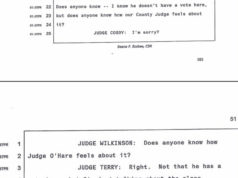No problem on this end – that’s what we expect – and probably what the Weekly itself has done on plenty of occasions, although Static likes to hope its bosses are more willing to give credit where due. So after the Weekly ran “Blowing Up The West Side” (Feb. 8, 2006), giving the first details of a $200 million housing and retail and office development that should change the Cultural District dramatically, the delay in reaction from the Star-T wasn’t surprising. But a month later, and still there’s been nothing from the big paper.
It’s not like Weekly staffer Dan McGraw had a lock on info regarding the development to be called Museum Place. JaGee Holdings, the developer, has filed a 60-page grant proposal with the North Central Texas Council of Governments. The partners have met publicly with business and neighborhood groups and even posted details on a web site run by the architectural firm they’ve hired. But the last time the S-T mentioned Museum Place was in a Jan. 23 business brief on a property sale. It said, “JaGee has been mum about the project, which it plans to launch this year.” Well, JaGee isn’t being mum, but the Ignore-o-Gram is. Even Static can’t figure that one out.
George P’s for George W’s War
They handed out the George Polk Awards in New York a couple of weeks ago, and Static found the news very instructive. The Polk, given out by Long Island University, is one of the more prestigious awards in the journalism world, honoring courageous reporting and photography across many venues (Static’s deskmate is the proud owner of one from 1990, but don’t hold that against ’em).
This year, there was a decided theme to LIU’s list of the winners. One went to a Chicago Tribune team for a series on “a trail of forced labor and human trafficking” from Nepal to the Middle East, financed by a $12 billion contract to – did you guess? – a subsidiary of Halliburton. One to ABC for revealing the CIA’s use of “enhanced interrogation techniques” such as simulated drownings (what regular people call “torture”) in the agency’s secret detention facilities.
Two to the Washington Post, the first to the reporter whose stories revealed the existence of those secret CIA lockups and the second to the reporting duo who trekked across Afghanistan to document that “claims of the U.S. reconstruction process [there] were a sham and a waste of millions of dollars.” That’s four of 14 awards that went to journalism that uncovered corruption among businesses and government agencies connected to the United States’ so-called war on terror and the bloody, terrifying fiasco in Iraq that is supposed to be part of it. (Not to mention another fistful of honors to journalists who uncovered or commented on various forms of corruption touching other parts of the federal government.)
You can say a lot of unflattering things about American journalists these days (Static frequently shouts those things itself, usually while listening to local newscasts). But you can’t say they’re not trying – at the risk of lives, limbs, and careers – to get the word out.
Contact Static at static@fwweekly.com.











